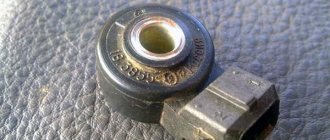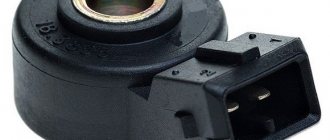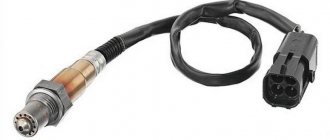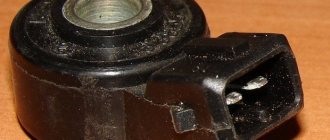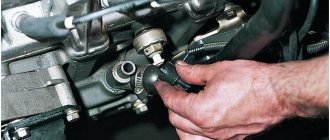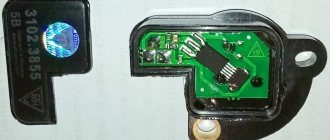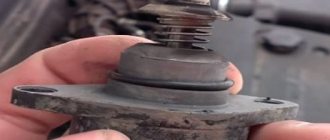About the sensor
The sensor is used to detect detonation and misfires in the engine. Structurally, the DD is similar to a piezoelectric element; a winding is placed inside the sensor. When detonation occurs in the engine, a slight vibration occurs through the sensor, which allows a small amount of voltage to be generated and transmitted to the electronic control unit. When the ECU receives signals from the DD, it understands that detonation is occurring in the engine and it is necessary to adjust the fuel mixture.
Symptoms of a problem
It should be noted that judging the operation of the sensor by signs is not an accurate method, since other sensors can also exhibit symptoms of failure similar to sensor failure. You can accurately determine whether the sensor is failing using diagnostics.
- Ringing of fingers when sharply pressing the gas pedal;
- High fuel consumption;
- Misfires;
Causes of detonation and measures to prevent it
Of course, the quality and type of gasoline used in the car is decisive. For example, the lower the octane number of the fuel, the less resistance to detonation. The quality of the fuel also plays an important role in the stable operation of the engine. Therefore, always pay attention to the choice of gas station, do not fill with low octane gasoline. The causes of the problems may also lie in faulty spark plugs, as a result of which the fuel in the cylinders does not ignite properly, and therefore signs of detonation appear.
What happens if the causes of detonation are not eliminated in time?
If you ignore problems associated with the engine, as time passes, small vibrations will inevitably develop into stronger ones. As a result, serious damage will occur in the form of destruction of the piston group. In addition, the internal combustion engine will constantly heat up, and if no active action is taken in this situation, a major engine overhaul will not take long.
Symptoms indicating problems with the knock sensor (DS)
1. Knock when the internal combustion engine is running; 2. Deterioration of acceleration (loss of traction); 3. Significant increase in fuel consumption (which does not depend on the time of year); 4. Engine tripping; 5. Disturbed exhaust (increased amount of exhaust gases, appearance of soot, persistent smell of gasoline). 6. Errors appear: 0325 - 0328 inclusive.
Common malfunctions of the Kalina knock sensor Device breakdowns can be caused by various reasons, including: - a short circuit in the network; — mechanical failure of the device itself; — breakage of wires or braid; — oxidation at the junction of the contact block with the sensor; — malfunction of the engine control unit.
Examination
The sensor can be checked using diagnostics at a service station and using a multimeter. We will consider the second option in detail because of its low cost and independence.
Sensor tester
To check, the sensor must be removed.
- We take a regular multimeter and switch its switch to measure a constant voltage of 200 mV.
- We connect the probes of the device to the sensor and hit the metal part of the sensor with a metal object. The readings on the device should change; if this does not happen, we can conclude that the part is faulty.
DD check
How to check the functionality of the sensor
To determine whether the knock sensor is working or not, it must be tested. To check, the device will need to be dismantled. Also in the process you need to stock up on a multimeter that connects to the sensor terminals.
To carry out the test, the necessary measuring parameters are set on the device, after which the working side of the knock sensor is knocked on a metal surface. Simultaneously with the action being performed, you should pay attention to the indicators of the multimeter. If no changes occur on the device screen during tapping, then the sensor is faulty.
If you don't have a multimeter at hand, you can use another diagnostic method. It consists of checking the voltage supplied to the DD terminal block. To perform the test, you will need to disconnect the block from the sensor and take measurements using another measuring device - a voltmeter.
The engine must be running while using the device, and the voltmeter must be in AC mode. The malfunction will be proven if it turns out that the voltage does not change.
During the check, you need to pay attention to the fact that the problem may not always be associated with a sensor malfunction. Sometimes the absence of the necessary indicators or reactions of devices can be caused by a break in the wires in the system or the oxidation of an element.
What happens if you don’t change the DD?
If you neglect to replace the sensor, then detonation in the engine will begin to progress and cause irreversible damage to the engine and bring major repairs ahead of schedule. Also, the operation of the sensor directly affects engine power and its consumption; the cost of the sensor is not comparable to the costs of subsequent repairs or the costs of increased fuel consumption.
Operating principle of DD
The piezoceramic element of the knock sensor, reacting to vibrations of the cylinder block, sends a signal to the controller (ECM), which, in turn, processes this signal and, in the event of detonation, reduces the ignition timing . In this case, the ignition timing changes for each cylinder separately. This is due to the fact that the temperature of the cylinders, when arranged in a row, is different. The coldest is the first, the hotter is the fourth or last, then the second and the hottest is the third.
From the driver’s point of view, the presence of a detonation elimination system makes it possible, if necessary, to use low-octane gasoline (keep in mind, the controller will assume that you have A-95). Another advantage is maximum efficiency and excellent dynamic qualities when using gas-cylinder equipment.
Replacement
- Disconnect the negative terminal of the battery
- Remove the connector from the sensor
- Unscrew the 13mm sensor with a wrench
- We dismantle the sensor and clean the DD seat with sandpaper
- Install the new one in reverse order.
We hope our article was useful to you.
Installation location
The sensor is mounted on the cylinder block on a special protrusion near the second cylinder. This arrangement is due to the greatest manifestation of detonation in this particular place. It’s easier to examine the knock sensor if you crawl under the car and remove the engine protection. The DD is located under the cylinder head on the radiator side. On an 8-valve engine, getting to the sensor and replacing it will be easy. But on a 16-valve system, the task is complicated by a large number of attachments that interfere with the process.
1 — knock sensor on engines 21126, 11194
Knock sensor on engine 21214.
How much does DD cost for Priora and Kalina
When a sensor fails, it is not repaired, but simply replaced with a new one. The original DD for 8 and 16 valve engines, which is installed on Priora and Kalina from the factory, has article number 21123855020 and costs about 280 rubles. There are also good analogues:
- ERA (550489) - 440 rubles;
- Fenox (SD10100O7) - 270 rubles;
- STELLOX (0609012SX) - 350 rub.;
- REMCOM (RK02001) - 210 rub.
in our VKontakte group
DIAGNOSE YOUR CAR YOURSELF!
Code P0327 is entered if the following conditions exist:
engine crankshaft speed is more than 1300 rpm; coolant temperature above 60°C; the amplitude of the knock sensor signal is below the threshold. If a permanent malfunction occurs, the “CHECK ENGINE” lamp lights up after 2 drive cycles.
1. The existence of conditions for the occurrence of code P0327 is checked.
2. The serviceability of wires 2 B and 88 G is checked.
HOW TO CHECK:
1. Connect the adapter cable to the diagnostic connector. Start the engine and warm up to a coolant temperature of 60°C. Set the engine crankshaft speed to more than 1300 rpm.
Code P0327 is intermittent. If it is currently inactive and there are no other codes, analyze the conditions under which the code occurred. It is necessary to check the knock sensor connector for foreign liquids (motor oil), dirt and dust getting into it. In case of severe contamination, clean with gasoline or any solvent that does not destroy plastic and rubber seals. See “Fault Cards” and “Checking the Knock Dampening System” card.
2. Turn off the ignition. Disconnect the harness connectors from the controller and knock sensor. Check the resistance of wires 2 B and 88 G with a multimeter.
Wire resistance less than 1 ohm indicates a malfunction of the sensor or controller, or poor contact in their terminals.
If the wire resistance is more than 1 ohm, repair the break.
After repair, start the engine, reset the codes and make sure there is no signal from the “CHECK ENGINE” lamp.
Since May 2013, our portal has expanded the thematic sections of the forum for the exchange of experience: subforums Americans, Koreans, Germans, French, Japanese have been added, due to the increase in the fleets of our visitors.
In addition to changing the style, our Chat, Mail, Entertainment and photo/video sections, Literature have become built-in and do not require separate registration. In addition, there are other useful and pleasant innovations that you can all familiarize yourself with when visiting the portal.
Problems
It is the Lada Kalina knock sensor that can cause breakdowns. For example, the engine loses power, etc. If the reason is in the specified sensor, the “Check Engine” indicator on the car’s dashboard will light up. In addition, machine diagnostics will reveal one of the error codes:
- P0325 - means an open circuit of the knock sensor Lada Kalina;
- P0327 – Low signal level;
- P0328 – Signal level high.
As for the location, the Lada Kalina knock sensor is marked in the photo with the number 16.
Reversing sensors Kalina
The reverse light switch sensor is required to ensure that the vehicle's rear lights turn off at the same time that the reverse gear is turned off. This device is located on the gearbox housing. A special solenoid is installed in the gearbox housing, blocking the engagement of reverse gear. If the reverse sensor does not work, the driver will not be able to engage reverse. This detail in the Lada Kalina car, according to reviews from car owners, is one of the most capricious.
Breaks and damage to the solenoid wires often occur, which some drivers prevent by treating the connections with silicone sealants. On approximately every third car of the model in question, the solenoid may fail even several times every six months. Bringing the reverse sensor back to life, even with a simple wire break, is not so easy. This is explained by the fact that the part is very difficult to access due to its location.
Features of phase sensor and shock sensor
The phase sensor (PF) of the Lada Kalina is installed on the cylinder block plug. Its signal is used by the ECU to sequentially inject fuel into the cylinders, that is, the phase sensor helps the ECU monitor the so-called engine strokes (intake, compression, combustion, exhaust) and supply fuel when needed.
It is possible to verify that the phase sensor is faulty only with the help of diagnostic devices, because the nature of engine operation when the phase sensor fails usually does not change. Fuel consumption may only increase slightly. Sometimes the engine starts with a slight delay because the ECU is looking for a signal from the sensor, but does not find it.
If it is necessary to replace the DF, you need to remove the plastic cover of the cylinder block to make it easier to get to the device itself. Carefully remove the connector with wires from it and, using a 10mm wrench, unscrew the fastening bolt, after which the sensor can be removed from the engine.
The new device is installed in the same place. DF is also called camshaft position sensor. When dismantling the device, it may happen that the sensor seems to grow to its place and does not want to be removed. In this situation, special pliers will help.
The shock sensor is installed as part of the standard anti-theft alarm system for the Lada Kalina. As a rule, a car of this model has a mount for such a sensor, and of a single-level type. However, car enthusiasts have learned to install non-standard two-level devices. The two-level shock sensor is connected quite easily without major changes to the standard wiring.
Sensors with an output transistor are often installed, configured for certain security zones (for example, the hood or doors). A two-level impact sensor is the most preferable because it reacts differently to impacts of different strengths, which allows you to assess the degree of danger to the vehicle. But it is important to consider that this device requires fine tuning. As a rule, it is done using a special adjusting screw.

